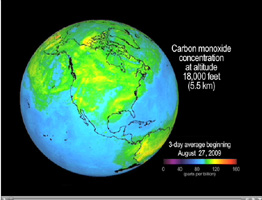Concentration and Transport of Carbon Monoxide from the California Wildfires

Click on the image for movie
Beginning August 26, 2009, and continuing into September 2009, a large wildfire in the Angeles National Forest north of Los Angeles known as the Station Fire burned more than 140,000 acres through September 3. Carbon monoxide in the smoke from this large fire was lofted as high as 8.3 kilometers (27,000 feet) into the atmosphere, where it was observed by JPL's Atmospheric Infrared Sounder (AIRS) instrument onboard NASA's Aqua satellite.
This movie, created using continuously updated data from NASA's "Eyes on the Earth 3-D" feature on NASA's global climate change website (http://climate.nasa.gov), shows three-day running averages of daily AIRS retrievals of the abundance of carbon monoxide present at an altitude of 5.5 kilometers (18,000 feet). AIRS is most sensitive to carbon monoxide at this altitude, which is a region conducive to long-range transport of the smoke. As the carbon monoxide is lifted by the fire's heat and blows downwind, it appears in the August 30 AIRS map north and east of the fire as a yellow to red plume that stretches from Southern California across Nevada and Utah. The plume is transported eastward on subsequent days, crossing Denver on August 31, southeastward to Texas on September 1, and reaching the Louisiana Gulf Coast on September 2. As the plume moves further east, mixing of carbon monoxide down to Earth's surface could adversely impact air quality, as it has already done in Salt Lake City and Denver. Previous studies using AIRS data have documented the impact of distant fires on air quality in Houston and other locations [McMillan et al., 2008, JGR, doi:10.1029/2007JD009711; McMillan et al., 2009, JGR, doi:10.1029/2009jd011973].
About AIRS
The Atmospheric Infrared Sounder, AIRS, in conjunction with the Advanced Microwave Sounding Unit, AMSU, senses emitted infrared and microwave radiation from Earth to provide a three-dimensional look at Earth's weather and climate. Working in tandem, the two instruments make simultaneous observations all the way down to Earth's surface, even in the presence of heavy clouds. With more than 2,000 channels sensing different regions of the atmosphere, the system creates a global, three-dimensional map of atmospheric temperature and humidity, cloud amounts and heights, greenhouse gas concentrations, and many other atmospheric phenomena. Launched into Earth orbit in 2002, the AIRS and AMSU instruments fly onboard NASA's Aqua spacecraft and are managed by NASA's Jet Propulsion Laboratory in Pasadena, Calif., under contract to NASA. JPL is a division of the California Institute of Technology in Pasadena.
More information about AIRS can be found at http://airs.jpl.nasa.gov.
